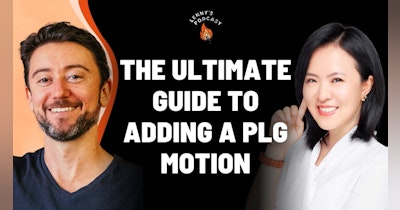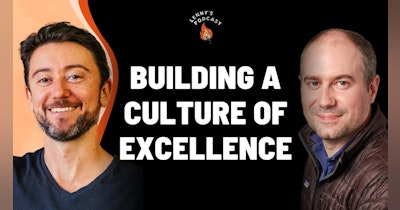Teresa Torres is an internationally acclaimed author, speaker, and coach. She teaches a structured and sustainable system for continuous product discovery. She’s coached hundreds of teams at companies of all sizes and over 11,000 (officially!) PMs via the Product Talk Academy and hundreds through her coaching practice, and is the author of *Continuous Discovery Habits*.
You can also see the episode transcript and Teresa’s references.
What is the “opportunity solution tree framework”? ▶️
It's just like a decision tree. It starts with an outcome at the root of the tree, and then it branches into the opportunity space and then it branches into solutions, and maybe even assumption tests from there.
It adds structure to complex process of moving from outcome to deciding what to build. It helps teams transition from an output focus to an outcome focus by breaking down the problem.
- Focus on the opportunity space, not solution space. The heart of good product development lies in framing the problem well by identifying users' unmet needs, pain points and desires. However, most people struggle with distinguishing between the opportunity space and solution space, tending to jump straight to solutions.
- Structure the opportunity space with an experience map. To identify opportunities, map out the overall user experience of trying to achieve an outcome.
As we break down major opportunities into smaller ones by moving down the tree, we eventually find opportunities that are actionable. In case of Netflix
Maybe I can't find something to watch because I don't know if this show's any good. Then we can learn about how do people evaluate shows. Maybe there's a small opportunity in there of who's the cast? It's one of the ways I evaluate a show. Now we're getting into an opportunity that we can actually solve.
The benefits of moving down the tree is that we can make strategic decisions to play where we want, address issues, and still contribute to bigger opportunities.
Why do we usually approach opportunity finding the wrong way? ▶️
- Opportunity finding requires skill and hard work; requires diligent critical thinking to analyze stories and extract key insights.
- Gain context from customer stories, not direct questions. Direct questions lead to superficial answers that lack context and nuance. Interview customers by asking them to describe experiences (”Tell me about a time when…”), not just answer standardized questions (”Do you watch Netflix…”).
- If I ask you, like, "Tell me about the last time you watched a movie," now I can collect things like where were you and who were you with and set the scene for me, and what happened first and how did you choose that? I'm going to get answers to all those direct questions, but it's grounded in this specific instance.
- Frame specific opportunities, not broad wishes. Vague opportunities like "make it easier to use" leads to endless, undirected work. In contrast, a specific opportunity, e.g. "entering passwords on Apple TV is difficult with an imprecise remote" targets a solvable problem for particular users.
What should you do if your company is a feature factory? ▶️
- Be proactive in understanding the outcomes that matter to your business. Even when you're being prescribed a fixed roadmap, you can still find customers to talk to, whether it's within or outside your company's working hours. The idea is not to wait for permission but to actively seek understanding.
- I hear from people all the time say, "I'm not allowed to talk to customers." I go, "Okay, well, your company doesn't own you when you're not at work. I bet you know people like your customers. Why don't you just start there?”
As an IC, don't wait for organizational change. Instead, focus on developing habits that align with outcome-oriented thinking.
What is continuous discovery, and why is it so important ▶️
Continuous discovery is about building continuous feedback loops. Unlike physical products, digital products are never done (like a project). They are continually evolving to meet ever-changing customer needs.
We're continuously evolving our products, which means we're continuously making decisions about what to build and, therefore, I think we need to continuously include the customer in that process. So for me, I define continuous discovery as building in those continuous feedback loops.
What do you do if your leaders tell you there’s no time for user research? ▶️
- Don't treat user research as project-based; instead, incorporate it continuously throughout the development process.
The best way to kill any appetite for discovery is to say, "Let's stop making bets until we discover." No, don't do that. Keep making bets. In parallel, start doing some discovery so that eventually those bets get better.
- Automate the interviewing process to make continuous discovery a habit. We can take inspiration from the idea of 'choice architecture' and 'nudging' to design a system where product teams find it easier to interview every week than not to. For example, we can put recurring weekly customer interview meetings on the calendar so that the interview is automatically scheduled without any extra work.
How can you automate weekly conversations with customers? ▶️
- Let customers opt-in to weekly interviews while using your product. We can design our product experience in a way that allows customers to opt-in for a weekly 20-minute interview. For example, we can show an NPS-like survey in the product that asks 'Do you have 20 minutes to talk to us?' instead of measuring NPS.
- For B2B customers, use internal teams like Sales and Support to recruit for interviews. We can define a 'trigger' or target profile for the type of customer we want to speak with that week and ask these internal teams to schedule interviews with matching customers during their normal conversations.
- Not all solutions require deep discovery.
- That's a common misunderstanding, I think. I think we need to do really robust, good discovery on the things that are part of our core product experience or going to be differentiators. We don't really have to do really amazing core discovery on the forgot password flow if it's working fine and you're not hearing about it as a pain point.
- Many free or low-cost tools exist to enable automated recruiting and scheduling. For scheduling, we have options like Calendly, Outlook, Google Calendar, Salesforce Lightning Scheduler. For in-product recruiting, we can use Qualaroo, Ethnio, Intercom, Usabilla, Chameleon and Hotjar
How do you stay unbiased as a PM about a potential solution? ▶️
Measure the impact of every solution you build. Instrument your product to measure the impact of everything you release so you can identify where risks actually lie in your ideas.
Overindex on discovery, especially when new to it. Do more discovery than you think you need, especially when you're first building the skill. This helps you get better at assessing risk and determining which ideas truly need more discovery.
Compare multiple solutions, not just one. Work through multiple options by comparing and contrasting the pros and cons of each to guard against choosing an obvious solution that may not actually be the best.
When you're looking for a place to live, you don't look at one apartment or house. You look at multiple, you compare and contrast. When you're looking for a job, you don't talk to one company. We know if we want to make good decisions, we need options and we need to evaluate the pros and cons of each. The same is true in the product world.
A PM's role isn't to be the decider. Don't fall into the trap of thinking a PM must have the final say or is the "CEO of the product." This mentality breeds internal politics and closes you off from better solutions.
Should a PM have more say over other functions? ▶️
Focus on collaborating, not roles. Teresa thinks of it like friends collaborating in the real world. Eg marshmallow challenge.
Teams are given spaghetti sticks and some tape and some string and a marshmallow. They're told to build a structure to get the marshmallow as high as possible… Kindergartners just start doing. They don't worry about their rules. They don't worry about who's in charge. They just brute force trial and error. What do MBA students do? There's posturing, like who has power and who's the decision-maker and who's right? We need a plan and we need to have a strategy. They spend the whole time negotiating this political social space instead of just doing. I really think we've got to learn how to get back to just doing.
What are Teresa’s best tips for how to interview customers? ▶️
- Keep the interview conversational. This creates a comfortable environment that helps the customer open up and share their story. I actually tell people if your interview feels like you're having a beer with a buddy, that's a good sign. It should be that casual and that conversational.
- Elicit customer stories through curiosity: Use questions to help customers recount their experiences chronologically by asking about specific events, characteristics, and scenarios.
- One of the reasons why we get bad at interviewing, we're so worried about asking the next question, we stop listening to the interviewee…We missed those moments of like, "Oh, there is some friction. You couldn't find something to watch. Tell me about that.”
- Focus on past behavior: When collecting customer stories, concentrate on what customers have done, rather than what they think or would do.
- It's a garbage in, garbage out situation. The real measure is tell me about your behaviour. What did you actually do? We have to help people do that.
How does discovery change as your company grows? ▶️
The need for lateral collaboration increases as your company grows. As your company grows, the number of adjacent teams increases, and with them, dependencies to manage. You'll need to rely on design patterns, libraries, and work closely with adjacent teams for a coherent and consistent UX.
Always prioritize data in decision making, even if it's limited. Critique making decisions based on limited user research by saying "Every human in business is making decisions with zero data. So I'm going to go with one is better than zero."
When should you do user research and when should you run an experiment? ▶️
Focus on sustainable qualitative research methods. Qualitative interviewing is a good method for identifying opportunities such as unmet needs, pain points, and desires that can be done sustainably week over week. Although observations may provide better insights, they may not be feasible for most teams on a regular basis.
Shift mindset towards continuous discovery. Teams struggling with testing ideas are likely still stuck in the project-based research world, running expensive and time-consuming experiments. For continuous discovery to be sustainable, teams need to change their habits and break ideas into underlying assumptions, prioritize them and run tests that are small enough to just test those assumptions.
Check out her book Continuous Discovery Habits, and her blog, producttalk.org, to learn more about continuous discovery and assumption testing practices.
This is a human edited summary of the podcast episode with Teresa, by Gaurav Chandrashekar (@cggaurav, productscale.xyz). To listen to the full episode, go here.








